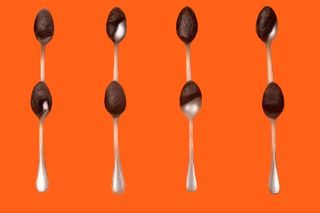
Could Chyawanprash be the Next Big Thing in Wellness?
The West is about to snatch up the dreaded cure-all of our childhoods.

You dread getting sick as a kid. It’s not the neti pots or the sponge baths. Instead, it’s the time of day when you are pulled into the kitchen, dread and phlegm building up inside your little chest, and made to stand in front of the counter. The spoon is pulled out from the drawer, and you immediately begin resisting. Anything but the spoon.
And then you see the jar, which spurs an instinctive, possibly violent reaction in you. Sometimes, the honey jar might even be brought out beforehand to assure you something good will follow. But screw the honey, you think. The honey doesn’t do shit. All of a sudden, you are face-to-face with the enemy: a spoonful of chyawanprash, heading straight for your mouth.
The color doesn’t help. Eating something as jet-black and disturbingly opaque as chyawanprash could only appeal to a monster. But the taste is the true kicker — it feels like ingesting a thousand wailing demons, each of which has manifested as a very specific Ayurvedic herb, all rolled into one impossibly sticky tar (to call it a ‘jam’ would be an insult to all other jams).
After it’s over, the adult responsible for inflicting this upon you tells you, while spooning the useless follow-up honey into your poor mouth, that they took this daily when they were a kid, and they never got sick.
As an adult myself, I have come around to many of the cold remedies I couldn’t stand in my childhood (with the exception of the sponge baths… those can remain in the 20th century). Dare I say I even sort of enjoy using a neti pot. And even more alarmingly, I’ve started taking chyawanprash daily, even when I’m not sick. By choice.
Chyawanprash tastes like ingesting a thousand wailing demons, each of which has manifested as a very specific Ayurvedic herb, all rolled into one impossibly sticky tar.
Because I’m now much less resistant to doing uncomfortable things for the sake of my health, I got the idea to start taking chyawanprash again while hate-stalking a Californian health food company. It markets several beautifully packaged ‘dusts’ to sprinkle on your food. The whole thing, I thought, felt suspicious, like it had a ‘life-changing’ 2003 vacation to India written all over it. When I saw amla and ashwagandha on every one of their ingredient lists, I knew why I’d smelled a familiar rat: These are also the primary ingredients in chyawanprash.
I’ve watched with folded arms as the West has co-opted staples from my childhood, like yoga, pranayam, turmeric, and moringa, bestowing on them the characteristically glossy sheen of the new age. It seemed like they haven’t figured out the full concept of chyawanprash yet, just a few of its ingredients — but it’s only a matter of time. How can you beat dozens of ancient Ayurvedic herbs, formulated over centuries to fit into one handy miracle jar?
So I started eating chyawanprash again, mostly in the hopes of beating the West at its own game. I had visions of running a chyawanprash empire abroad, using my own incredible stamina and vitality as the main selling point.
Since I started taking it daily about a month ago, I haven’t been sick once, but then again, I’ve only been sick twice in the last year, so that may not be saying much. It does taste much better to me now — I can appreciate anything that has ghee and honey in it — although it’s not quite the same as eating a spoonful of Nutella straight out of the jar.
I have wondered if it’s helped my stress levels at all, since ashwagandha is an adaptogen — a natural substance that helps your body manage stress and regulate sleep. Stress is a hard thing to measure over time, and I can’t say I’ve noticed much change in my sleeping pattern. But evidence-based studies do suggest that adaptogens work, and have even found molecular mechanisms to explain how they do.
Amla, chyawanprash’s other key ingredient, is also supposed to be a real heavy lifter. Indian gooseberry, as it’s otherwise called, claims to balance your stomach acids, even out your skin, strengthen your liver and brain function, and even improve muscle tone. Dr. Ramesh Nair, a general practitioner in Mumbai, isn’t sure about chyawanprash’s other claims, but he thinks the amla in it, at the very least, is beneficial. “Amla is a good source of vitamin C, fiber, and so many [other] things,” says Dr. Nair. “So, to that extent, having [chyawanprash] will be good, I suppose.”
Given that science keeps evolving its positions on wellness and health food, and that there are so many other ingredients in chyawanprash science has yet to account for, it’s hard to say yet what health benefits it objectively, and indisputably, delivers. But there may, in fact, be a possibility that chyawanprash can cause you harm, a fact that I unfortunately discovered only after taking it for a month.
A 2009 study found that 20% of Ayurvedic products contain detectable lead, arsenic, and mercury levels. Canada has banned several Ayurvedic products for containing such toxic metals. And India has banned its Olympic athletes from taking chyawanprash, stating that, in addition to the metals, some chyawanprash brands even contain steroids. I was faced with the possibility that, instead of helping my body, I had been causing a lot of damage.
Dr. Nair, who is aware of these findings, believes there isn’t much cause for concern, if you’re careful about which brand of chyawanprash you buy. “The only problem with Ayurvedic products is that some of them do contain heavy metals,” he says. “There are some good companies making [chyawanprash], like Dabur, and all that, which are supposed to be reputed companies, having good quality control.”
The Ayurvedic products that have made names for themselves in the West have experienced similar falls from grace, on a much more public scale. For example, scientists continue to flip-flop on the effectiveness of curcumin, the so-called cureall substance in turmeric. In general, the only conclusive outcome on most Ayurvedic miracleworkers is that further study is warranted. So where does that leave health-conscious Indian millennials who want science to back Ayurveda’s many claims?
“I wouldn’t stop [patients] from taking it, if they’re already taking it,” Dr. Nair says. “I would say okay, if you feel good about it, continue.” That seems to be the golden rule when it comes to Ayurveda and health foods that science doesn’t support (yet): If they make you feel good, there’s no reason not to take them. At the very least, the placebo effect might be able to help you.
While Dr. Nair wouldn’t prescribe chyawanprash to his patients, he thinks there may be something to all the fuss around it, based on how many people have touted its claims over the centuries. “I have nothing against it,” he says. “It is effective, I suppose, because it’s been around for quite some time.”
In other words, if you’d like to eat chyawanprash because it makes you feel stronger, healthier, or happier, so be it. It seems like an activity that makes a lot more sense for your health than using a neti pot to pour water into your nostrils — and that’s been proven to work.
At home, chyawanprash is simultaneously hated, for the collective memory of being forced to eat it as children, and revered, for its supposedly miraculous properties. Big local brands are already making mint on its health-boosting claims, and now, niche organic companies are jumping on board. But despite all this, chyawanprash doesn’t yet have the same ubiquity as it would if it were to become the latest health food abroad, promoted by fitness and food bloggers, nutritionists, and yoga teachers. Then, it would be exported back to India, and we’d have to pay through our noses for it, just as we do for turmeric lattes and aerial yoga.
I don’t know if I’ll be repurchasing a jar of chyawanprash when my current one runs out — I’m not fully sure I’ve erased all of the negative associations I ascribed to it in childhood. But before we submit this, too, to the vicious cycle of the Western new age, I suggest we take matters into our own hands. What if we packaged chyawanprash in trendy glass jars (no yogis to be found), called it “artisanal ancient herbal jam,” and started exporting it ourselves? Whether or not we’d have any additional health and stamina from all the chyawanprash we’d be eating, at least we’d still have the last laugh, watching the rest of the world spread it on their gluten-free toast.
Urvija Banerji is the Features Editor at The Swaddle, and has previously written for Rolling Stone India and Atlas Obscura. When she's not writing, she can be found in her kitchen, painting, cooking, picking fights online, and consuming large amounts of coffee (often concurrently).
Related


Study: Marijuana Use During Pregnancy Affects Infant Size, Behavior
